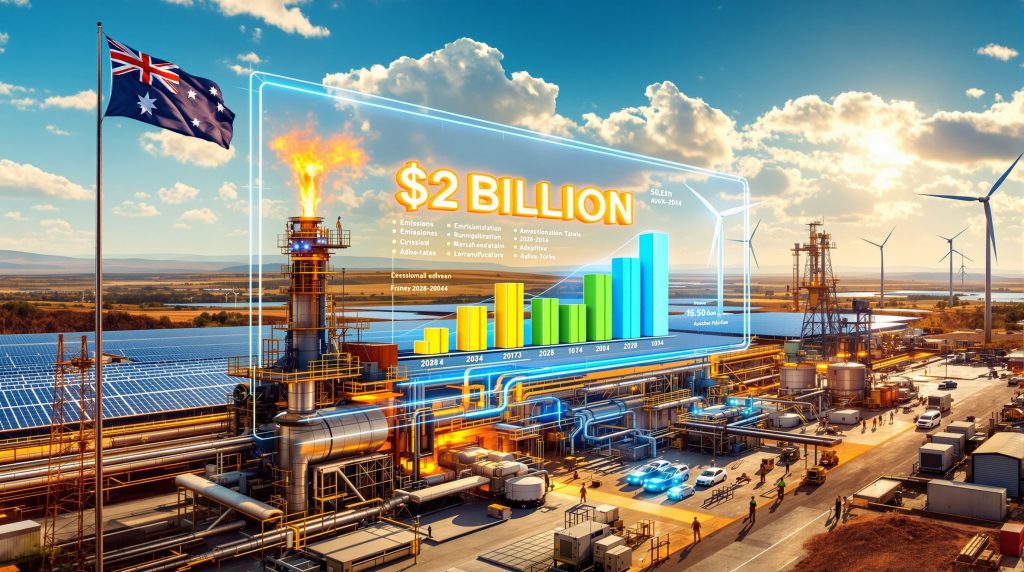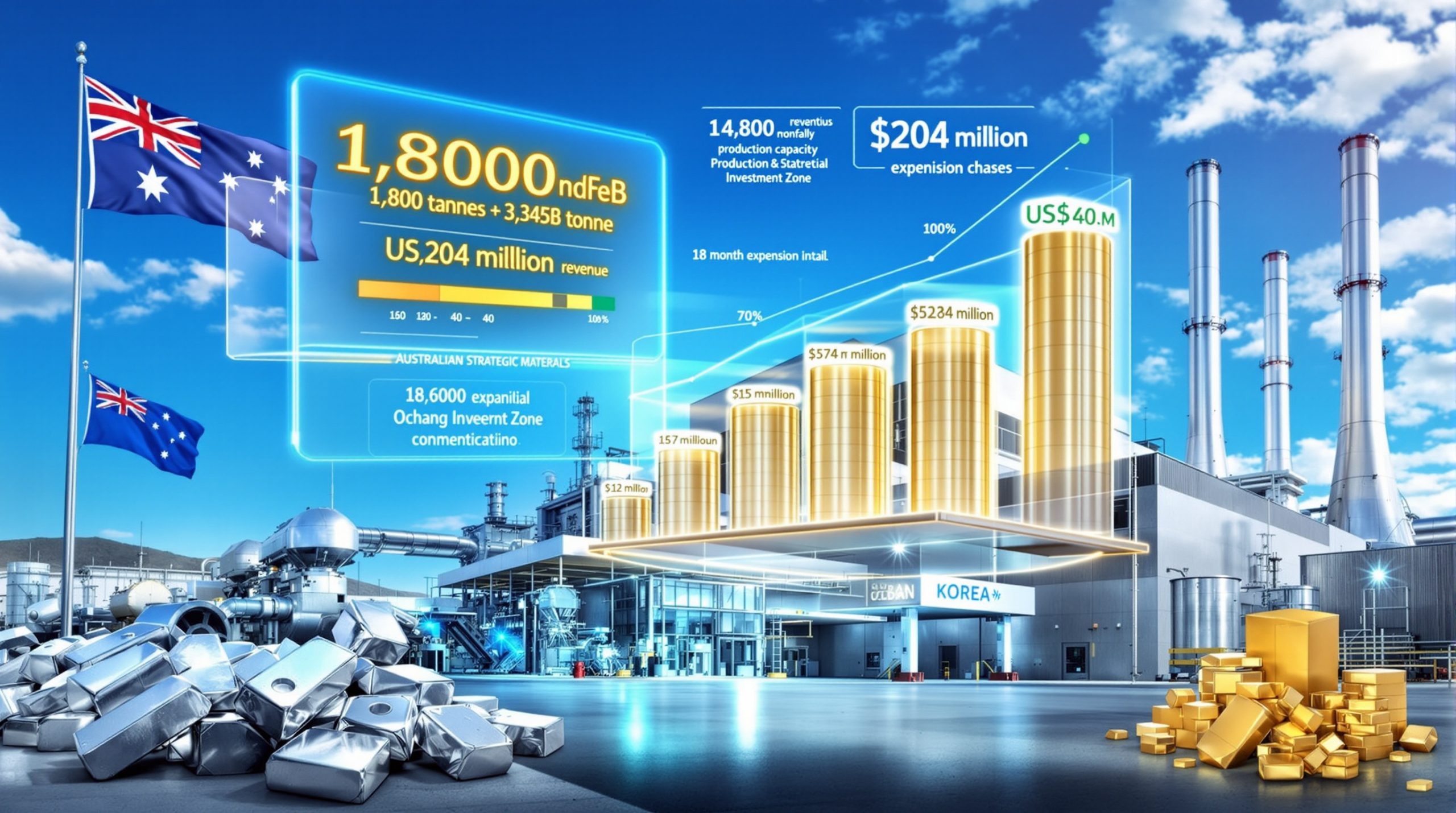Australia's $2 billion green aluminium production credit represents a transformative shift in how the nation approaches industrial decarbonisation. This comprehensive scheme provides financial incentives to aluminium smelters that commit to renewable energy sources, fundamentally altering the competitive landscape for one of Australia's most energy-intensive industries alongside broader critical minerals energy transition initiatives.
The framework operates on a straightforward principle: facilities receive production credits for every tonne of aluminium manufactured using clean energy sources. This direct financial support mechanism aims to bridge the cost gap between traditional coal-powered smelting and renewable energy alternatives, making the transition economically viable for operators across the country.
Understanding the Green Aluminium Production Credit Framework
Core Components of the GAPC Initiative
Under the scheme parameters, green aluminium is defined as metal produced through smelting operations powered primarily by renewable energy sources. The verification standards require comprehensive documentation of energy sourcing, with facilities needing to demonstrate consistent renewable energy usage throughout their production cycles.
The credit calculation methodology remains subject to consultation outcomes, though the program structure indicates payments will be made per tonne of verified green aluminium output. This performance-based approach ensures taxpayer funds directly correlate with environmental outcomes rather than simply supporting facility upgrades.
The operational timeline spans from 2028 to 2044, providing a 16-year window for industry transformation. However, individual facilities face a maximum support period of 10 years, encouraging early adoption while preventing indefinite dependency on government assistance.
Financial Structure and Allocation Mechanisms
The $2 billion total investment will be distributed across eligible facilities based on their production volumes and renewable energy commitments. While specific per-tonne rates await final program design, industry observers expect credits to substantially offset the premium costs associated with renewable energy procurement.
Payment schedules will likely follow quarterly or annual disbursement cycles, tied to verified production data and renewable energy consumption records. This regular payment structure provides operators with predictable cash flows to support ongoing renewable energy investments and facility modernisation projects.
Disclaimer: Specific credit rates and payment mechanisms are subject to consultation outcomes and final program guidelines expected in early 2026.
Which Australian Smelters Will Benefit from the Production Credits?
Australia's aluminium smelting landscape comprises four major facilities strategically positioned to serve both domestic and export markets. These operations represent approximately 1.6 million tonnes of annual production capacity, making them significant contributors to both economic output and greenhouse gas emissions.
Eligible Facility Requirements
Current operational capacity serves as the primary threshold for program eligibility, though specific minimum production levels remain undefined in available documentation. The consultation process will likely establish these parameters based on facility scale, employment impact, and regional economic significance as part of advancing mining industry innovation across the sector.
Geographic distribution across Australian states ensures balanced regional benefits:
• Tomago Aluminium (NSW): 590,000 tonnes annual capacity
• Portland Aluminium (Victoria): 358,000 tonnes annual capacity
• Boyne Smelters Limited (Queensland): 545,000 tonnes annual capacity
• Bell Bay Aluminium (Tasmania): 185,000 tonnes annual capacity
Employment considerations weigh heavily in program design, with the industry directly supporting approximately 4,000 workers across these facilities. Regional communities depend significantly on smelter operations, making the transition to renewable energy crucial for long-term job security and economic stability.
Major Industry Players and Their Participation
Each smelting operation faces unique challenges in transitioning to renewable energy sources. Coastal facilities like Portland and Bell Bay may leverage offshore wind resources, while inland operations such as Tomago could integrate large-scale solar installations with battery storage systems.
Facility modernisation plans will likely require substantial capital investments beyond renewable energy procurement. Upgrading electrolytic cells, improving energy efficiency systems, and installing monitoring equipment for credit verification represent significant operational undertakings that the production credits help justify financially.
Regional economic implications extend far beyond direct employment, with each facility supporting extensive supply chains and service industries. The transition to renewable energy could attract additional manufacturing investments to these regions, leveraging clean energy infrastructure for broader industrial development, potentially supporting projects like bauxite project benefits across the value chain.
How Does This Initiative Support Australia's Net-Zero Emissions Goals?
Aluminium production currently contributes 3-4% of Australia's total greenhouse gas emissions, making it a critical sector for achieving national climate objectives. The energy-intensive nature of electrolytic aluminium production means that transitioning to renewable energy sources can deliver substantial emissions reductions relatively quickly compared to other industrial processes.
Emissions Reduction Targets in Aluminium Production
The smelting process requires approximately 13,000-16,000 kWh per tonne of primary aluminium produced, making energy sourcing the dominant factor in determining environmental impact. Transitioning this energy consumption from coal-fired power to renewable sources could potentially reduce sectoral emissions by 80-90% over the program's operational period.
Australia's broader climate commitments include reducing emissions by 43% below 2005 levels by 2030, with updated 2035 targets under development as of late 2025. The aluminium industry's transformation represents a significant contribution toward achieving these goals, particularly given the sector's historical reliance on fossil fuel-based electricity generation.
International decarbonisation benchmarks increasingly influence global aluminium markets, with major consumers prioritising low-carbon metal sourcing. This market dynamic reinforces the strategic value of Australia's green aluminium initiative beyond domestic climate policy considerations, positioning the country for green metals leadership globally.
Renewable Energy Integration Strategies
Solar and wind power capacity requirements for smelters present both opportunities and challenges for grid integration. The continuous operation requirements of aluminium production demand reliable baseload power, necessitating substantial energy storage solutions or backup systems to maintain production stability.
Grid stability considerations become paramount when energy-intensive operations transition to variable renewable sources. Advanced forecasting systems, demand response capabilities, and storage integration will likely become standard components of green aluminium facilities.
Regional renewable energy infrastructure development could accelerate significantly as smelters commit to long-term clean energy procurement. These large-scale energy users provide anchor customers for renewable energy projects, improving project economics and encouraging additional clean energy investment in their regions.
What Makes This the Largest Industrial Decarbonisation Investment in Australian History?
The $2 billion allocation for green aluminium production credits represents an unprecedented scale of government support for industrial environmental transition. This investment magnitude reflects both the strategic importance of the aluminium industry and the substantial costs associated with renewable energy adoption in energy-intensive manufacturing.
Scale and Scope Comparison
Historical government manufacturing support programs typically focused on automotive industry assistance or regional development initiatives. The green aluminium production credit exceeds these precedents in both total value and duration, spanning potential 16-year operational periods compared to shorter-term industry assistance packages.
Within the broader Future Made in Australia initiative framework, the aluminium credit represents one of the largest sectoral allocations. This prioritisation reflects aluminium's strategic importance in renewable energy infrastructure, transportation electrification, and construction applications essential for broader decarbonisation efforts.
International comparisons reveal similar scale programs in major economies, though specific structures vary considerably. The United States' manufacturing incentives under recent legislation and European Union industrial decarbonisation funds provide comparable financial support, indicating global competition for clean manufacturing capability.
Strategic Positioning in Global Markets
Australia's competitive advantages in green aluminium production extend beyond government financial support to include abundant renewable energy resources, established mining and refining capabilities, and proximity to major Asia-Pacific manufacturing markets. Furthermore, these initiatives help address ongoing resource energy exports challenges by diversifying the national export portfolio.
Supply chain integration from bauxite mining through alumina refining to primary metal production provides Australia with unique value proposition opportunities. This vertical integration could support premium pricing for certified low-carbon aluminium products in increasingly environmentally conscious markets.
Export opportunities for low-carbon aluminium products continue expanding as international manufacturers face carbon border adjustments and sustainability reporting requirements. Australian producers positioned as reliable sources of verified green aluminium may command significant market premiums over conventional alternatives.
When Will the Credits Become Available and What Are the Implementation Milestones?
The program timeline establishes clear milestones for industry transition, beginning with the current consultation period and extending through nearly two decades of operational support. This extended timeframe provides certainty for long-term investment planning while maintaining flexibility for program adjustments based on technological developments and market conditions.
Program Timeline and Key Dates
Critical implementation milestones include:
• October 30, 2025: Consultation period closes
• Early 2026: Final program guidelines and eligibility criteria published
• 2027-2028: Application and assessment period for participating facilities
• July 1, 2028: First credit availability in 2028-29 financial year
• 2034-2044: Maximum support period conclusions for early participants
Facility transition deadlines will likely provide sufficient lead time for renewable energy infrastructure development and contractual arrangements. The multi-year preparation period recognises the complexity of transitioning large-scale industrial operations to new energy sources.
Application and Qualification Process
Eligibility assessment criteria will encompass operational capacity, employment levels, regional economic impact, and demonstrated commitment to renewable energy transition. Documentation requirements will likely include detailed energy transition plans, financial capacity assessments, and environmental impact evaluations.
Renewable energy certification standards must align with national renewable energy frameworks while providing sufficient flexibility for diverse geographic and technological approaches. Third-party verification systems may be required to ensure credit integrity and prevent fraudulent claims.
Production verification and reporting obligations will establish ongoing compliance requirements throughout the support period. Monthly or quarterly reporting cycles may track production volumes, energy consumption patterns, and renewable energy sourcing documentation to maintain program accountability.
How Will Global Demand for Low-Carbon Aluminium Drive Market Opportunities?
International market trends increasingly favour sustainable metals sourcing, driven by corporate sustainability commitments, regulatory requirements, and consumer preferences. This demand shift creates substantial opportunities for Australian producers positioned to supply verified low-carbon aluminium products.
International Market Trends and Premium Pricing
Growing industrial customer preferences for sustainable metals reflect broader supply chain decarbonisation efforts across multiple sectors. Automotive manufacturers, construction companies, and packaging producers increasingly specify low-carbon materials to meet their own environmental targets and reporting obligations.
Regional demand patterns across Asia-Pacific markets show particular strength, with major economies implementing carbon pricing mechanisms and industrial policy frameworks that favour low-carbon inputs. Japan, South Korea, and emerging Southeast Asian markets represent substantial opportunities for Australian green aluminium exports.
Price premium potential for certified green aluminium varies by market segment and certification standards, though industry analysis suggests premiums of 5-15% above conventional aluminium prices for verified low-carbon products. These premiums could increase as carbon pricing mechanisms expand globally.
Competitive Positioning Against International Producers
Australia's renewable energy cost advantages continue improving as solar and wind technologies achieve grid parity with fossil fuels in many regions. This cost competitiveness, combined with government production credit support, positions Australian smelters favourably against international competitors facing higher energy costs or carbon pricing.
Quality standards and production consistency factors remain crucial for maintaining market position, regardless of environmental attributes. Australian smelters' established reputations for reliable supply and consistent quality provide foundational advantages in pursuing green aluminium market segments.
Logistics and shipping considerations for export markets add complexity to competitive positioning, though Australia's established trade relationships and shipping infrastructure support efficient market access. Long-term supply contract opportunities may provide stability for both producers and customers navigating the transition to sustainable materials.
What Challenges and Risks Could Impact the Program's Success?
Technical implementation hurdles represent the most immediate challenges facing participating facilities. The transition to renewable energy sources for continuous industrial processes requires sophisticated planning and substantial infrastructure investment beyond government credit support.
Technical Implementation Hurdles
Renewable energy reliability for continuous smelting operations poses the greatest technical challenge, as aluminium production cannot accommodate significant power interruptions without substantial facility damage. Electrolytic cells require consistent power supply to maintain molten metal states and prevent costly production disruptions.
Infrastructure upgrade costs extend beyond renewable energy procurement to include energy storage systems, grid connection improvements, and facility modernisation requirements. These capital investments may total hundreds of millions of dollars per facility, requiring careful financial planning despite production credit support.
Technology integration challenges encompass energy management systems, production monitoring equipment, and renewable energy forecasting capabilities. Maintaining operational efficiency while transitioning to variable energy sources demands sophisticated control systems and operational expertise.
Market and Economic Risk Factors
International aluminium price volatility impacts program economics significantly, as production credits provide fixed support while revenue depends on global commodity markets. Price fluctuations could affect facility profitability and investment return calculations throughout the extended support period.
Currency fluctuation effects on export competitiveness add additional complexity for facilities serving international markets. Australian dollar strength relative to customer currencies can offset green aluminium premium advantages, requiring careful financial risk management.
Competition from other low-carbon metal producing regions continues intensifying as governments worldwide implement similar support programs. Canadian, Norwegian, and other producers with abundant renewable energy resources may challenge Australia's competitive position in green aluminium markets.
How Does This Initiative Compare with International Green Metal Programs?
The global policy landscape for industrial decarbonisation support continues evolving rapidly, with major economies implementing varied approaches to support clean manufacturing transitions. Australia's production credit model represents one approach among multiple policy tools being deployed internationally.
Global Policy Landscape Analysis
European Union Carbon Border Adjustment Mechanism (CBAM) implementation creates both opportunities and challenges for Australian aluminium exports. While CBAM may disadvantage high-carbon competitors, compliance requirements add administrative complexity and potential cost burdens for exporters.
United States manufacturing incentives under recent legislation provide substantial tax credits and direct support for clean energy manufacturing, though specific aluminium industry provisions differ from Australia's production credit approach. The scale and structure of US support creates competitive pressure for Australian policy makers.
Chinese industrial decarbonisation targets increasingly influence global aluminium markets, given China's dominant production share. Chinese government investments in electric arc furnace technology and renewable energy procurement could significantly affect international competitive dynamics.
Canadian critical minerals and clean technology strategies leverage abundant hydroelectric resources to support low-carbon aluminum production. This natural advantage, combined with government support programs, positions Canada as a significant competitor in North American and global markets.
Best Practice Integration and Lessons Learned
Successful renewable energy transitions in other energy-intensive industries provide valuable insights for aluminium sector transformation. Steel industry experiences with electric arc furnace adoption and renewable energy integration offer relevant technical and economic lessons.
International certification standards for green metals continue developing through industry associations and standards organisations. Australian program design must align with emerging global frameworks to ensure market acceptance of certified products.
Cross-border carbon accounting methodologies remain under development, with implications for trade competitiveness and program effectiveness measurement. Harmonised approaches to emissions calculation and verification could benefit all participating nations.
What Are the Long-Term Economic and Environmental Outcomes Expected?
Regional development implications extend far beyond the four smelter locations to encompass broader manufacturing ecosystem opportunities. Clean energy infrastructure developed for aluminium production could support additional industrial investments and economic diversification in these regions.
Regional Development and Employment Impacts
Job creation opportunities span renewable energy development, facility modernisation, and expanded manufacturing capabilities. While direct smelter employment may not increase substantially, supporting industries and service sectors could benefit from increased investment and activity levels.
Skills transition programs will be essential for existing workforce adaptation to new technologies and operational requirements. Training initiatives covering renewable energy systems, advanced control technologies, and environmental monitoring could enhance worker capabilities and career prospects.
Community investment opportunities arise from increased economic activity and government program requirements. Infrastructure improvements, educational initiatives, and local business development could generate lasting benefits beyond the production credit period.
Environmental Benefits Beyond Emissions Reduction
Air quality improvements in smelter regions represent significant co-benefits of renewable energy transition, particularly for communities historically affected by coal-fired power generation. Reduced particulate emissions and other air pollutants could yield substantial public health benefits.
Water usage efficiency enhancements may accompany facility modernisation efforts, as newer technologies often require less water for cooling and processing applications. These improvements could reduce environmental impacts in regions facing water scarcity challenges.
Waste reduction and circular economy integration opportunities include improved recycling capabilities and byproduct utilisation. Modern smelting technologies often generate fewer waste products while enabling better recovery of valuable materials from production processes.
Frequently Asked Questions About the Green Aluminium Production Credit
Eligibility and Application FAQs
Who can apply for production credits?
Operational aluminium smelting facilities meeting capacity and renewable energy transition requirements will be eligible, though specific thresholds await final program guidelines publication in early 2026.
What documentation is required for renewable energy verification?
Comprehensive energy sourcing documentation, third-party verification certificates, and ongoing consumption monitoring data will likely be required to maintain credit eligibility throughout the support period.
How are production volumes measured and reported?
Monthly or quarterly production reporting systems will track eligible aluminium output, with verification requirements ensuring accuracy and preventing double-counting across different support programs.
Financial and Operational FAQs
How are credit amounts calculated per tonne of production?
Specific calculation methodologies await final program design, though credits will likely reflect renewable energy usage percentages and verified production volumes through standardised formulas.
Can facilities receive credits for partial renewable energy use?
Graduated credit systems may provide proportional support for facilities achieving specific renewable energy thresholds, encouraging incremental progress toward full renewable energy transition.
What are the tax implications of receiving production credits?
Production credits may constitute taxable income requiring careful financial planning and professional tax advice to optimise overall economic benefits for participating facilities.
| Metric | Value | Timeline |
|---|---|---|
| Total Investment | $2 billion | 2028-2044 |
| Maximum Support Period | 10 years per facility | Until 2044 |
| Current Industry Emissions | 3-4% of national total | Baseline 2024 |
| First Credits Available | 2028-29 | Financial year |
| Consultation Closes | October 30, 2025 | Application period |
| Program Duration | 16 years maximum | 2028-2044 window |
| Australian Smelting Capacity | 1.6 million tonnes | Annual production |
| Direct Employment | 4,000 workers | Current facilities |
The transformation of Australia's aluminium industry through the $2 billion green aluminium production credit represents more than an environmental initiative – it embodies a strategic repositioning for long-term competitive advantage in the global clean economy. As international markets increasingly demand sustainable materials and governments implement carbon border adjustments through measures like the new Green Aluminium Production Credit, Australian smelters supported by this program may find themselves uniquely positioned to capture premium market opportunities while contributing significantly to national climate objectives.
Success will ultimately depend on effective implementation, industry commitment to renewable energy transition, and continued government support throughout the extended operational period. The program's substantial scale and duration provide unprecedented opportunity for industrial transformation, though technical challenges and market risks require careful navigation by participating facilities and policy makers alike.
Disclaimer: This analysis is based on publicly available information as of October 2025. Specific program details, credit rates, and eligibility criteria remain subject to consultation outcomes and final government decisions. Prospective participants should consult official government sources and seek professional advice regarding program participation and financial implications.
Looking to Capitalise on Australia's Green Metals Revolution?
Discovery Alert's proprietary Discovery IQ model delivers real-time alerts on significant ASX mineral discoveries, instantly empowering subscribers to identify actionable opportunities in the evolving critical minerals and green metals space. Understand why major mineral discoveries can lead to substantial market returns by exploring Discovery Alert's dedicated discoveries page, showcasing historic examples of exceptional outcomes, and begin your 30-day free trial today to position yourself ahead of the market.




